Monthly Archives: April 2013
And then there are the setbacks…
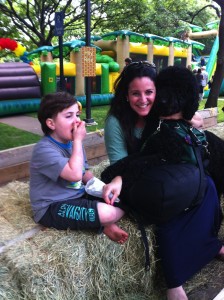 As my confidence grows and my search for a weekend therapist lingers on, I have embraced each weekend as a chance for new adventures. Barry was sick last weekend, so I heroically offered to let him stay in bed and rest on Saturday while I managed the kids. After hearing Zoe complain that she was bored for the 15th time, we called a friend of hers and invited her to the mall for lunch and walking around. Yes, I took 3 typical children, 1 child with autism and a dog to the mall BY MYSELF. That is how cocky I am getting. And, you know what? It went beautifully. Sure, the girls bickered and Gray asked (on his iPad) to be taken to the bathroom multiple times, but when we left, I felt no more frazzled than any other parent who takes a group of kids to the mall. The day was a huge success: the kids had fun, we burned a few hours, Barry heralded me as the best wife ever for letting him sleep off his cold and I felt good about the world.
As my confidence grows and my search for a weekend therapist lingers on, I have embraced each weekend as a chance for new adventures. Barry was sick last weekend, so I heroically offered to let him stay in bed and rest on Saturday while I managed the kids. After hearing Zoe complain that she was bored for the 15th time, we called a friend of hers and invited her to the mall for lunch and walking around. Yes, I took 3 typical children, 1 child with autism and a dog to the mall BY MYSELF. That is how cocky I am getting. And, you know what? It went beautifully. Sure, the girls bickered and Gray asked (on his iPad) to be taken to the bathroom multiple times, but when we left, I felt no more frazzled than any other parent who takes a group of kids to the mall. The day was a huge success: the kids had fun, we burned a few hours, Barry heralded me as the best wife ever for letting him sleep off his cold and I felt good about the world.
So, as you would expect, I was looking forward to the carnival at Lena’s preschool on Sunday. We had already done a carnival at the elementary school, the weather was beautiful and Barry felt well enough to join us. What could go wrong?
Within moments of arriving at the carnival, the girls ran to the petting zoo and Gray ran for a bounce house. Barry and I split up: he had Zoe and Lena while I took Gray and Hope. As we traveled from activity to activity, I made little mental notes of questions I never thought to ask during my training with Kati:
Is it wise to put a dog in a bounce house? (I didn’t, of course, but the idea was amusing.)
What to do when Gray enters the bounce house (alone) and jumps right out of his tether belt so that I have nothing to hook him to when he comes back out? (A: Ask a preschooler who has just barely mastered the English language to go in the bounce house and “get that black strap over there in the corner…not that corner, over there…no, not there…YES, YES! That strap there! No, don’t put it on, bring it to me, please.”)
If Hope goes in the petting zoo, does she become one of the petting attractions?
What is the best way to load a boy and dog who are tethered together on to a tractor for a hay ride?
Yes, the day was great fun and everyone was enjoying the carnival, until…a kid got in the bounce house wearing glasses. Gray is obsessed with ripping glasses off of people’s faces. It’s a charming habit. As soon as I saw that kid get in the bounce house, my stomach dropped. Gray lunged for the glasses and pulled them off that poor boy’s face before he even realized he was under attack. The kid screamed and tried to grab his glasses back. I tried to reach my arm through the webbing of the bounce house “window” to get hold of Gray’s arm. I yelled for the kid to wait and let me get the glasses back for him. I knew that the glasses would not hold any interest for Gray now that they were off of their owner’s face. I knew that, if the kid would just relax a second, Gray would drop them or give them to me. Of course, this 4-year-old now missing his glasses was only slightly more coherent than Gray. He was clearly panicked to get his glasses back and started a game of tug-of-war that miraculously ended with him rolling over backwards with his glasses in his hand. I only took a moment to celebrate the glasses remaining intact. Now, Gray had snapped into full-blown mania. He started laughing hysterically and dropping kids to their knees with pinches or hair-pulling.
Hope and I leapt over many small bodies to run back to the front entrance of the bounce house. I thrust Hope’s leash into the hand of the bewildered attendant at the entrance and told her to hold my dog while I saved those kids. It was like a scene out of a bad comedy: Gray was moving lightening-fast among his victims and small children rolled around crying for their moms inside the mesh barriers. I dove head first into the entrance and caught Gray by an ankle. As I dragged him out, other parents looked at me with confused and horrified eyes. I don’t know how many times I apologized. I really think I just kept repeating it like a mantra, “I’m so sorry. He is autistic. I’m so sorry. He is autistic.”
As I pulled him free of the bounce house and got him to his feet, I turned to gather Hope and re-attach her tether to Gray’s belt. That’s when Gray sank his hand into a lovely mop of curly hair. The girl with the lovely hair shrieked and I whipped around to start untangling Gray’s fingers. I began my mantra again, but the mother was clearly unnerved by how long it was taking me to get Gray to let go. I tried to explain that it would take me a minute to get his hand unclenched, but she did not seem to understand what I was saying. I finally freed the girl and left her to cry in her mother’s arms as Gray and I escaped the scene.
I saw Barry across the way, and I just pointed to the car and yelled, “we will meet you there!” He nodded and started to gather the girls. When we finally made it back to the car, I could not wait to get Gray locked down in his car seat. It wasn’t until after I got him untethered and into the car that I realized: In all the excitement, he had soiled his pants and it had run down his legs. I now had it all over me and the car seat. I buckled him in and put Hope in the far back of the 3rd row so that she would not become another casualty. I cursed my glove box that only held dried-out wet wipes. I even withheld my sarcastic remarks when Barry arrived with the girls and said, “Wow, it smells terrible in this car!”
So, believe it or not, I think that the event was more or less a success. I mean, we had 90 minutes of family fun before disaster struck. If only people would stop bringing their glasses-wearing kids out to places like this, it would prevent problems like these from ever happening!
My second radio interview
Full disclosure: Before and after my last radio interview, I was a little bit of a wreck. I was nervous and fidgety as I waited for my call from the station and, afterwards, I did not feel good at all. I can only describe it as feeling like a deflated balloon. I guess there had been an adrenaline rush that left my body after I hung up the phone and I was left with a headache and a queasy stomach. Thankfully, I did not have the same experience with this interview. Because the last one went so well, I felt confident and relaxed as I sat in a car on my cell phone 1 mile from my house. I feel like this is important practice for me so that I can get ready for the “big interviews” that I hope will someday come. I know that I am recording something important here. I know that many people will benefit if they can hear my story. I pray that the opportunities will come so that I can get my message out:
There may not be a cure for autism yet, but there is a very real way to make life better while we wait!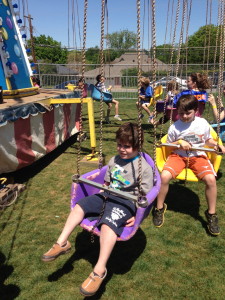
Click to listen to my radio interview: Kati is at the 11 minute mark and Rhoni is at the 17:45 mark
Insurance companies are evil
 As I navigate the financial strains of therapy and doctor appointments for Gray, I am constantly bumping up against our insurance company. It reminds me of the courtroom scene from John Grisham’s movie “The Rainmaker.”
As I navigate the financial strains of therapy and doctor appointments for Gray, I am constantly bumping up against our insurance company. It reminds me of the courtroom scene from John Grisham’s movie “The Rainmaker.”
Q: Well, let’s talk about this mysterious section U. Why don’t we explain it to the jury. Take a look at it. Just read paragraph 3.
A: (reading) Claim handlers are directed to deny all claims within three days of receipt of claim. No exceptions.
Q: Now how do you explain this section U?
A: Well, sometimes we get some frivolous and fraudulent claims in our business. And sometimes we have to use this kind of language to focus in on the legitimate and more needy claims.
Q: Mr. Keely, do you honestly expect this court to believe that explanation?
A: Well, this chapter merely denotes in house processing guidelines.
Q: In-house processing guidelines? No, Mr. Keely, no it does not. Section U does a lot more than that.
A: I don’t think it does that, son.
Q: Mr. Keely, doesn’t it explain how claims should be rerouted and shuffled and rerouted, anything to avoid payment?
A: I admit nothing.
PL atty: Your honor, approach the witness?
Judge: You may.
Q: (Baylor hands Keely a huge book.) Now Mr. Keely, how many policies did great Benefit have in effect in the year 1995?
A: I don’t know but let’s see–
Q: Does the figure 98000 sound correct, give or take a few?
A: Maybe, that could be right, yeah.
Q: Thank you. Now of these policies, how many claims were filed?
A: Well, I don’t know that.
Q: Does the figure of 11,400 sound correct to you, give or take a few?
A: That’s about right, but I’d have to verify it, of course.
Q: I see, so the information I want is right there in that book? Can you tell the jury, of the eleven some-odd thousand claims that were filed, how many were denied?
A: Well, I don’t think I could. That would take more time.
Judge: You’ve had two months, Mr. Keely. Now answer the question.
A: Well, I, I don’t think (shuffling through book) Uh, 9141.
PL atty: 11462 filed, 9141 denied
That about sums up my experience with the insurance companies. They deny the claim first and then wait to see if anyone protests. In the early days, I would set aside about 90 minutes each week to argue with my insurance company. It was a maddening time-suck and often ended up with me in frustrated tears after requesting to speak with supervisors and enduring up to half-a-dozen transfers per call. I would marvel at the effort they would put me through. Occasionally, I would find a sympathetic representative and I would convince them to give me their direct contact information so that I could send my botched claims to someone who new what I was talking about. In the end, I would always get my claims paid, but I mourned for the other families in similar situations who likely did not have the same success I did. After all, I was a physical therapist who had spent my career fighting with insurance companies on behalf of my patients. I understood terms like “in-network,” “out-of-network,” “deductible,” “co-insurance,” and “pre-authorization.” I had armed myself with the Texas state law (House Bill 1919) that was originally written as a brain injury bill but had a section in it called the autism mandate that forced insurance companies to pay for behavioral therapy and nullified limits on speech, occupational and physical therapy for children who had an autism diagnosis. I had a copy of this mandate saved in my email so that I could send it or reference it whenever I needed to enlighten the person I was fighting with. What in the world were other families doing who did not have the information or the time to fight or the fortitude to reject the constant denials?
Over the years, the fight has gotten easier. Autism is twice as prevalent as it was 6 years ago (the frightening truth of that is best saved for another post). The insurance claims have, no doubt, followed this trend. Now, my insurance company has assigned me an “autism care advocate” in an effort to streamline these claims and keep track of their veracity. I can say now that I can go for many weeks without having to correct an insurance error and those that do require correcting only take up 15-20 minutes of my time. I have been feeling more comfortable with the process…until 2 weeks ago.
Gray’s behavioral therapist is a private practitioner who has worked with him for over 2 years. Because there were not a lot of “in-network” behavioral therapists when we started with her, the insurance company worked out an individual contract agreement with her. That means they negotiated her rates to their in-network standards and she had to file her reports with them so that she could get approval for the number of hours she could work with him each week. This was more work for her and less for me, but she took it on.
Last month, his weekly hours were up for re-approval. She filed all the paperwork and had a phone conference with the “peer reviewer.” (I love this term. It implies that the person on the other end of the line is a peer professional. Of course, they have similar credentials, but the fact remains that they work for the insurance company. After the review process was over, they decided that Gray did not qualify for the 20 hours per week that he had been receiving and dropped his allotment down to 15 hours per week. Never mind the evidence that showed he has been making progress (at a snail’s pace) and, therefore, really needs more therapy instead of less. We began the appeals process. This is in spite of the fact that my autism care coordinator told me that the decision was beyond appeal. In essence, she said “Here is an address you can write to. It won’t help, but at least you will feel like your complaints were heard.” Thanks. I needed a way to spend my extra time.
Then, two weeks later, Gray’s therapist told me that she had just received word that the insurance company was not renewing her individual contract and she would no longer be considered in-network. Of course, no one from the insurance company notified me of this. Of course, I was given no notice to consider my options. I called my autism care advocate to ask what was happening. He told me that the insurance company had more in-network providers now and they were trying to move their customers over to these bigger companies instead of using individual contracts. I told him that was all fine and good for new customers who had never worked with a therapist before, but kids with autism need consistency. It would be a horrible backslide to make Gray re-establish himself with a new set of therapists. I told him that I didn’t understand why our therapist’s contract had to be cancelled when it was causing no extra cost to the insurance company…she was billing the same as their in-network providers and she was submitting all paperwork according to their standards. I explained that this would not only be a disruption to Gray’s care, but it was a monumental task for me to search out a new provider whose schedule would match Gray’s availability. As I felt the tears welling up, I explained that parents like me have enough on our plate without having to spend our time arguing with insurance companies. He told me he understood because he has conversations like these everyday. I asked him, “You tell people that they have to flip everything over in their child’s life everyday? Your job title is ADVOCATE. Do you know what that word means?” When I asked if I could speak with his supervisor, he denied me access to her contact information and said he would send her a message to see if she might be willing to talk to me.
So, for the next 3 days, I called him and made him spend about 30 minutes on the phone with me as we rehashed the discussion above and I asked when I could expect to hear from his supervisor. Each time he denied me her contact information, but in our last conversation he gave me her name. I hung up the phone and called the main number for the insurance company. I explained to the person on the line that I had just been talking to <<supervisor’s name>> in the autism coordination department and our call was cut short. I asked if she could connect me to her directly and give me her extension to continue our conversation. It worked! Moments later, I was leaving a message on her voicemail that was lengthy, detailed and firm.
The next morning, I received a phone call from my autism care advocate. He informed me that he had been reviewing Gray’s case with his supervisor and they decided it would be in his best interest if they extended the contract another 6 months. They also encouraged my therapist to apply for in-network status so we could avoid this problem in the future. I thanked him for being so helpful and asked him to thank his supervisor as well.
Victory. For now. Now, how about that reduction in his weekly hours…
Halloween: Past and Future
Why am I writing about Halloween in April? Well, I have had some people ask me what life was like for Gray and our family before Hope. I am accustomed to rattling off a list of things that can and do happen when we have been out in the community, but it occurred to me that Halloween would be a perfect example of the progression we have made and where I hope to go.
Halloween is a BIG holiday in our neighborhood. The decorations on the houses around here rival Christmas and sometimes even surpass them. Trick-or-treating is one of the most anticipated events of the year and we always celebrate at a friend’s house whose street gets a lot of traffic. She orders pizza, we all take turns passing out candy and taking kids to the houses. Someone usually throws up from too many sweets: it’s a memorable event. Through the age of 4, we always just took Gray along in a stroller while Zoe ran up to the houses. He enjoyed being out, as long as we kept moving. He usually ended up falling asleep in the stroller after we parked it next to us on the porch and passed out candy.
Two years ago, I decided to give Gray a shot at trick-or-treating. The class at his pre-school program had been practicing it and I wanted to see how it would go. At first, Gray was happy and intrigued. We walked hand-in-hand along side Zoe who was thrilled to have her brother along. She patiently walked at his pace and escorted him up to the first house. She explained to the people at the door that he could not speak, but he loved candy. (Side note- Gray does not like candy. As sweet as Zoe’s intentions were, she absolutely seized on the opportunity to double her candy intake.) I helped Gray to open his bag and he marveled when strangers dropped things inside. We had a similar experience for 2 more houses. Then, Zoe grew impatient with our painfully slow progress. She started running ahead. Gray continued to be content just walking with me and looking at all the people for about 10 more minutes. Then, he started getting upset and struggling to have me release the grip I had on his hand. He was tired of holding hands and he wanted to be free. As soon as I loosened my grip, he pulled free and started bolting across lawns. In the dwindling light, I struggled to find him and imagined him just disappearing into the crowd. It was reminiscient of the scene in E.T. where Elliot can’t find his alien friend because the streets are filled with small people in costume. When I finally caught him, he dropped to the ground in full-on meltdown. I had squashed his goals (goals that no one could know) and now he had to endure me holding onto him again. As I threw his kicking and screaming body over my shoulder, I found Zoe and told her that we needed to head back.
 Last year was the first year that Gray was really proficient on his iPad. One of his amazing therapists agreed to come along with us and practice using his new communication skills. The iPad was loaded with all the necessary Halloween phrases and we ran dry-runs in his classroom and around the house. On Halloween evening, we loaded up and headed over to our friend’s house. Unlike in years past, she decided to go with fried chicken for dinner. Otherwise, everything was just as it had been every year. Gray burst into the house with great expectation. Then, he started whining. When we pulled out his iPad, he just kept pressing “pizza.” This is notable because, as I have mentioned before, only very close friends invite us to their houses. This is a house that we visit quite often, throughout the year, with and without various meals included. It was interesting to me to know that Gray had observed the cues to know that this was Halloween and he could expect pizza. Unfortunately, there was no pizza to be had, so Gray was pissed.
Last year was the first year that Gray was really proficient on his iPad. One of his amazing therapists agreed to come along with us and practice using his new communication skills. The iPad was loaded with all the necessary Halloween phrases and we ran dry-runs in his classroom and around the house. On Halloween evening, we loaded up and headed over to our friend’s house. Unlike in years past, she decided to go with fried chicken for dinner. Otherwise, everything was just as it had been every year. Gray burst into the house with great expectation. Then, he started whining. When we pulled out his iPad, he just kept pressing “pizza.” This is notable because, as I have mentioned before, only very close friends invite us to their houses. This is a house that we visit quite often, throughout the year, with and without various meals included. It was interesting to me to know that Gray had observed the cues to know that this was Halloween and he could expect pizza. Unfortunately, there was no pizza to be had, so Gray was pissed.
After we weathered the storm of his disappointment, we headed out for an early before-sunset trick-or-treat session. I learned my lesson about going out with him in the dark. Because we were so early, we were among the first to hit the houses and Gray had plenty of time to practice his Halloween phrases for his new audience. People were amazed and encouraging. Everyone whose house we approached waited patiently for Gray to use his iPad and then they poured extra helpings of candy in his bag. Zoe was thrilled. Gray looked very proud. Things were going very well…until we hit house #5. As we approached this house, I could see that the owners were sitting on their porch with a bucket of candy. When Gray started running towards them at full speed, I felt optimistic that he was getting the hang of this. That is until I saw what he saw: The owners were enjoying a pizza outside while they waited for the kids to arrive. I broke into a full sprint and cut Gray off just before his grimy little hand landed in the middle of their dinner. Gray dropped to the ground and had a full-on fit right their on the porch of house #5. The owners became flustered and tried to comfort him with candy and compliments on his costume, but Gray was not to be comforted. As his therapist and I dragged him back towards my friend’s house, I tried to console myself with the little bit of success that came before the fall.
Just 50 feet from our destination, Gray pulled himself together and broke away from us again. The people across the street were having a little party on their front lawn and there was a stack of pizza boxes set up on a buffet table. Fortunately, we know these people from our swimming club and they know Gray. As he ran toward their front porch, the dad said, “Hi, Gray! Want some candy?” I explained that he would gladly trade all of his candy for a slice of their pizza. He said, “No problem, he can trick or treat for pizza!” As his therapist and I caught up to Gray, we thrust the iPad into his hand and asked him what he needed to do. He whined, but went through the motions of pushing his Halloween buttons. The dad was so impressed, he loaded up a paper plate with 3 slices and handed them to Gray.
We made our way across the street and Gray sat nicely at the table enjoying his well-earned pizza. It wasn’t quite the success I had hoped for, but it was a definite step up from the year before. At least this year, with the help of his new communication device, I knew what Gray’s goal were.
Of course, we haven’t had a Halloween with Hope yet, but I am already brainstorming dog/boy duo costumes!
Where should special-needs kids be special? by Amy S.F. Lutz
 A friend of mine saved this article for me to read. He thought it pertained well to our family’s situation. I couldn’t agree more. I never realized how much I weighed this issue in my own mind — I even went so far as to GET A SERVICE DOG for my son to improve our ease in the environment. I think that Ms. Lutz sums up my thoughts perfectly:
A friend of mine saved this article for me to read. He thought it pertained well to our family’s situation. I couldn’t agree more. I never realized how much I weighed this issue in my own mind — I even went so far as to GET A SERVICE DOG for my son to improve our ease in the environment. I think that Ms. Lutz sums up my thoughts perfectly:
Where Should Special Needs Kids Be Special?
Tricky questions about how to share public spaces.
By Amy S.F. Lutz
Earlier this year, I was out to dinner with a friend and our combined eight kids. My 14-year-old son, Jonah, who has autism, was very excited about the imminent arrival of his hamburger and french fries, so he was acting as he does when he’s happy: bouncing in his seat, clapping his hands, and vocalizing a mishmash of squawks and catchphrases from his favorite Sesame Street videos. He wasn’t exceedingly loud, but the oddness of his behavior had clearly caught the attention of an older gentleman at the one other table occupied at that early hour.
“Shhhhhhh,” he hissed from across the room.
Everyone at the table instantly froze—except, of course, for Jonah. “I’m sorry,” I explained, rising from my seat and taking a few steps toward him so I wouldn’t have to holler. “My son is autistic … ”
“Oh, sorry,” he said.
“He’s not trying to disturb you intentionally … ”
“I heard you the first time,” he snapped.
My face burned as I returned to my seat, his gratuitous nastiness instantly draining the joy from my evening. I spent the rest of the dinner constantly shushing Jonah, even though we had specifically decided to eat out at 6 on a Thursday night in a casual eatery so we wouldn’t have to hold any of the kids to impossible standards of behavior.
It turns out my friend and I weren’t the only ones who have been discussing the rights of disabled individuals in the community, the responsibilities of their families, and the expectations of the public, as we did that evening. Two recent high-profile incidents focused the nation’s attention on this very issue.
First, Whole Foods faced the ire of the autism community after a contracted security guard at a Milwaukee grocery allegedly told the sister of a 26-year-old autistic man who had taken some food from the hot bar that “he needed to get out of the store and not come back “unless he was on a leash.” Although the guard resigned, Whole Foods apologized, and sensitivity training was arranged for the entire staff, a spokesperson gently pointed out this wasn’t the first time Michael Goldman had helped himself from the prepared trays. Even if his sister paid for the food, as she offered to do, it’s unclear what expenses the store might have had to absorb if Goldman had used his hands, contaminating the entire tray. As the parent of an autistic teen who is also a threat to snatch food, I wondered along with many others why his sister hadn’t been glued to his side—or even, as I would have been, physically guiding him by the arm or shoulder—in such a tempting environment.
The next week, Michael Garcia, a waiter at a Houston restaurant called Lorenzo’s, received mass acclaim after refusing to serve a family who changed tables to get away from a 5-year-old with Down syndrome. The customer allegedly complained to Garcia that “special needs children need to be special somewhere else.”
To sum up the fallout from these incidents: It’s not OK to be offended by the sight of disabled people in the community or to insult them or their family members. However, neither is it OK for anyone, disabled or not, to engage in dangerous, illegal, and/or unsanitary behaviors.
Pretty broad parameters, no doubt, but hopefully ones we can all agree on.
Where it gets tricky is in the middle. What are reasonable expectations of behavior in public places? Like many autistic individuals, Jonah is virtually incapable of doing anything quietly. He has been scowled at on airplanes, in movie theaters, in restaurants, and in bookstores. And I get it—I prefer a quiet airplane ride as much as the next person. But what I keep coming back to is that community, by definition, is inclusive. Ideally, our public spaces should accommodate everyone. Which means that expecting kids like Jonah to just stay home isn’t reasonable. Nor should we think of this issue in terms of what discomfort or awkwardness people without disabilities are willing to tolerate, because that suggests a troubling hierarchy of privilege. Instead, we need to ask ourselves how best to share our common facilities.
As anyone who’s ever parented young children knows, there are two ways of sharing: taking turns or using something together. Turn-taking seems to be particularly in vogue of late, at least when it comes to autistic people in the community: Zoos, amusement parks, bowling alleys, roller skating rinks, movie theaters and purveyors of just about any type of entertainment imaginable are setting aside time particularly for individuals with autism and their families. These are fabulous programs that allow autistic children to have fun and try new activities. They also take the pressure off parents, who don’t have to worry their kids are being too loud or just too weird—because I think it’s often the strangeness of autistic behavior that disturbs people, not simply the volume. My four younger kids have done their share of enthusiastic joking and singing in restaurants and other public spaces, but no one has questioned the appropriateness of their presence as some have done after observing Jonah chant, “Mommy Aunt Keri with a Daddy song” while wiggling his fingers in front of his face until he goes cross-eyed.
There’s no question that separation makes things easier for everyone. After another older patron at the same establishment complained on a different night about Jonah watching his touch-screen device while waiting for his dinner, we permanently moved our group into a party room apart from the main dining room. I’m finally able to relax—we don’t have to make Jonah stay in his seat or constantly remind the seven other kids to use their “indoor voices.” Philosophically, however, it bothers me: What are my children, and my friend’s children, learning about the place of the disabled in the community? Will they grow up thinking it’s perfectly natural for people like Jonah to literally be shunted into a back room?
So I guess I prefer the messier way of sharing, where everyone’s in it together. This is typically what occurs, and typically it works out: We, the parents of potentially disruptive kids like Jonah, generally don’t take them to the ballet or other live performances that require quiet audiences. We take them to movies that have already been out for weeks, and we go at off times. Instead of going to the Four Seasons on Valentine’s Day, we take them to family-friendly restaurants where, honestly, it’s unreasonable for anyone to expect much ambience.
And most people are pretty accepting. They’re busy with their own affairs, for the most part. Even if they do notice us, they know it’s rude to stare, and I’ve actually caught several parents surreptitiously using us as a teaching moment to explain to their kids why they shouldn’t point. When Jonah bumps into strangers while he’s spinning, they usually accept our apologies and move on without making a big deal out of it. While there are obviously still those who feel that autistic children belong “on a leash,” I think there are more who want to help—people who let us step in front of them in line at Wendy’s, for example, because they know that waiting can be extremely difficult for kids in this population. And I have to say, there’s no charitable gesture I can think of that beats, in terms of pure value, letting a family with a child with autism or a similar disability cut in line. It costs only a few minutes of your time, but it can make a tremendous difference for that family, who may have been forced to leave—without their lunch, or their groceries, or even their turn down the waterslide—because of their child’s increasing agitation.
When the public routinely encounters disabled individuals in the community—sees them running the same errands, enjoying the same activities, and yes, even struggling with things that come easily for others, you get the level of compassion shown in an April 2012 segment of ABC’s “What Would You Do?” In the hidden-camera video patrons of a New Jersey restaurant universally supported the family of an autistic teen (all played by actors) against a single diner (also an actor) who was offended by the teenager’s disruptive behavior. What had me sobbing in front of my computer was that even when the actor playing the autistic boy actually snatched french fries off the man’s plate, the other diners rallied behind the family, comforted the parents, and applauded when the man stormed out.
I don’t expect that much acceptance. But I think we can do better than “I heard you the first time.”
My radio debut
As I mentioned in my last post, April is Autism Awareness Month. I’m not sure how bad a disorder has to get to warrant a whole month of awareness, but the newest statistics reveal that 1 in 50 children is being diagnosed with autism. That’s pretty alarming. At this point, we need more than awareness: we need a plan. I’m not sure why this hasn’t become a national crisis in the eyes of the government. If medical costs are making the national debt increase, then hold on to your hat because these kids are EXPENSIVE. Additionally, I am distraught at the lack of a plan for this kids long-term as they become adults. What will happen when 2% of our adult population needs long-term care? For now, I will settle for awareness with the hopes that it will aid in provoking a solution from people who are more equipped than me.
Awareness is a pretty broad topic. I think that the public is pretty “aware” that there is a situation on our hands. I think that is happening purely by the fact that, nowadays, pretty much everyone knows someone who has autism. In fact, when I talk to friends and acquaintances, it is pretty common for them to identify more than one person in their family or circle of friends who has a child with autism. The problem is that most parents are either too ashamed or too overwhelmed to be able to explain exactly what they are dealing with. I, on the other hand, have been blessed with a lack of shame and a compulsion to share my story with anyone who will listen. As I have been talking with people and getting feedback on this blog, the one comment I keep getting is, “I had no idea how difficult your life was on a day-to-day basis.” I have to admit that this comment surprised me. I really thought that I was doing a good job explaining our life with Gray so that people understood what we go through. Now, I realize that I often glossed over the gory details in an effort to prevent people from being uncomfortable and to make my life seem more “normal.” I guess, in a social setting, it is hard to get that message across. I mean, when you are out to dinner with friends and people start sharing stories about their kids, it’s kind of a buzz-kill to chime in with, “My kid ran out the front door naked today and started running towards the 4-lane road that is a block away from our house!” So, while I may continue to spare my dinner companions alarming stories like that, I will write about it and speak about it and do my best to explain it in a way that people can understand. If we want the public and lawmakers to be sympathetic and take action on our behalf, we must paint a detailed and accurate picture of the struggle that our children experience.
I also want people to know about autism service dogs and the amazing gifts they can give a family like ours. If someone reads my blog and decides that their family could benefit the way ours has, then I will be beyond thrilled. Last year, I went to a lecture where a man who is visually impaired described his experience with his service dog. He spoke about receiving his dog when he was in college and remembered the first time he walked across the campus without fear of being hit in the face by a branch or being caught off guard by a traffic light. He spoke about the incredible freedom his dog gave him to explore the world without being so vulnerable. I remember being moved by his story. I had no idea that Gray’s story would be so similar. I can honestly say that Hope is a guide for Gray that lets him explore his world while keeping him safe. In addition, she is an anchor that keeps Gray secure in knowing where he is supposed to be.
So, in the spirit of raising awareness, a radio station in Seattle asked ASDA if Kati could speak about their program and include a parent of a child with a service dog. Guess who got to make a radio debut???
Saturday Solo
 Let me start with a little disclosure: I have lots of help. During the week, I have a nanny that helps keep my house in order and shares the duties of shuttling my 3 kids around to various activities and therapies. On the weekends, I have had a person who will work with Gray or join us for family outings so that there is an extra set of adult hands. Unfortunately, this person recently relocated to another state and I have not been able to find the perfect replacement yet. Because Barry’s job has been so demanding and stressful lately, he has been working 7 days a week for months. That left me on my own last weekend with 3 kids to entertain.
Let me start with a little disclosure: I have lots of help. During the week, I have a nanny that helps keep my house in order and shares the duties of shuttling my 3 kids around to various activities and therapies. On the weekends, I have had a person who will work with Gray or join us for family outings so that there is an extra set of adult hands. Unfortunately, this person recently relocated to another state and I have not been able to find the perfect replacement yet. Because Barry’s job has been so demanding and stressful lately, he has been working 7 days a week for months. That left me on my own last weekend with 3 kids to entertain.
April is Autism Awareness month. That means that lots of organizations are doing autism-friendly events for families. This past Saturday, the Dallas Museum of Art put on a morning program for kids with autism and their siblings. I decided that an event like this would be my best bet for keeping all of the kids entertained in an environment where people would be understanding.
As we pulled up to the museum, I told Zoe that I was feeling nervous and I really needed her to be a helpful big sister. She said she was ready for the challenge. It turns out that I didn’t need her help at all. The event was lovely. There were craft rooms for the kids, a sketching station with a sculpture as a model, a sensory area and 2 different musical presentations. Gray was not too interested in the craft areas, but the girls really enjoyed them while Gray, Hope and I just walked around peacefully and enjoyed the sights. When it was time for the musical presentation, we all filed outside and sat nicely in the sunshine while we listened to a violin performance. Many parents asked me about Hope and how she is helping Gray. It made me think that I really need to get business cards so that people can read about the two of them here on this website.
As the program was wrapping up, I told the girls we could go out to lunch somewhere. We have become total pros at casual restaurants and I felt sure that Hope and I could handle these kids in a pizza place or somewhere similar. As we left the museum, we exited the building in front of our new downtown park. Food trucks lined the street with a children’s play area just beyond them. Zoe immediately asked if we could have our lunch at the food trucks and then stay at the park for a while. Feeling bolstered by the smooth morning, I told her that we could try, but I really didn’t know how it would turn out. With great ease, we walked to the corner, waited for the light to change and crossed the street to the park. After we identified a food truck that we all liked, we got in line. Gray tried to make a run for the front of the line, but Hope’s tether kept him close and bought me enough time to pull out his iPad and explain that we had to wait in line to get hamburgers. Unbelievably, this satisfied him and he waited with me (head buried in my hip) for almost 15 minutes while the girls played games nearby. Zoe proved to be an excellent waitress as she helped me carry everyone’s lunch to a little table. We settled in, I tied Hope’s leash to the tree next to Gray’s chair and we all enjoyed the beautiful weather and lunch. I kept looking around at everyone else in the park and I wanted to shout, “Hey, look at me! I’m eating my lunch in a public place with my kids and I have BOTH hands free! Look, my son is sitting all by himself!”
After lunch, the kids played on the playground for another hour or so and we headed home. As we drove out of the parking lot, Zoe beamed about what a fun day we had. I agreed. “We did it, Zoe! We don’t need a babysitter or therapist to come with us. We have got this down!”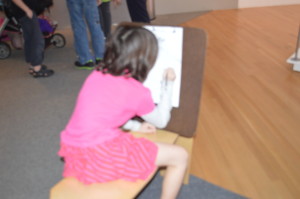

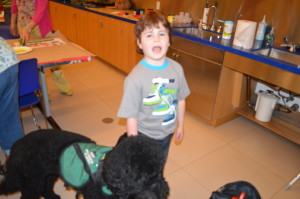

August is almost here!
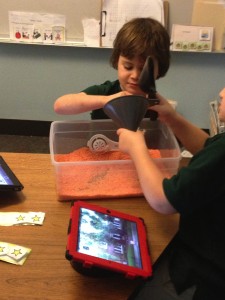 Every year around this time, I have to start thinking about how Gray will spend his summer and what school will look like for next year. It’s a difficult process because there are not a lot of options for kids like Gray. This year, we worked with a private school for children with learning differences to create a pilot program for kids who use iPads to communicate. This program has been really wonderful for Gray because of the talented teacher that leads his class and the other committed professionals who help things run smoothly.
Every year around this time, I have to start thinking about how Gray will spend his summer and what school will look like for next year. It’s a difficult process because there are not a lot of options for kids like Gray. This year, we worked with a private school for children with learning differences to create a pilot program for kids who use iPads to communicate. This program has been really wonderful for Gray because of the talented teacher that leads his class and the other committed professionals who help things run smoothly.
The focus in his class is on all learning happening through use of the iPad so that Gray and the other student in his class can unlock the power of communication beyond just asking for french fries. In order to make this happen, we have 1 teacher and 1 aide, an occupational therapist who sees each kid once a week, a physical therapist who sees each kid once a week, a behavioral therapist who observes and consults, and a speech therapist who specializes in augmentative communication devices that spends a whole day with the class once a week. As you can imagine, this program is expensive. Additionally, the school that Gray attends is not a school that was designed for children with autism. His school was founded to help children with learning differences, but it is not equipped to deal with the kind of behavioral issues that Gray brings to the table. The day that I arrived to pick him up and found him laying in the hall screaming while his teacher tried to keep him from injuring himself was the day that I knew his needs were starting to encroach on the needs of everyone else in the building. When you put together the cost of the program and Gray’s behavioral challenges, the school understandably decided to discontinue the program for next year.
So, I went back to the drawing board. After considering the limited school options for Gray, I have decided to give public school a try. I won’t lie. I am desperately afraid of how this will go. I have had many friends who have worked as therapists in the public schools and they all report that they feel inadequate in the care they can provide to special needs students due to limited resources. The one glimmer of hope is that, in the public schools, the squeaky wheel gets the grease…and I am an excellent squeaker. In the meetings to set up Gray’s Individual Education Plan (IEP), I made sure that I was very clear in expressing Gray’s level of disability and I was able to get them to approve a private aide for him in the classroom. Additionally, the teacher for his future classroom seems truly committed to her job and she has given me several examples of how she runs her classroom that make me believe she understands kids like Gray.
I pray that, with me as his advocate, Gray will have resources available to him that a small private school cannot provide. I pray that the district administrators will be able to understand the benefits that Hope can give to Gray. And, I pray that Gray will continue to thrive in yet another new environment.
There is no auto-pilot for the mother of a child with autism!
Practicing manners
 Last Sunday night, we were invited to dinner at a friend’s house. I reluctantly accepted the invitation after she assured me that there was nothing Gray could do that would mess up her house. I respectfully disagreed, but I thanked her for believing in us and told her we would come. In reality, I was thrilled with the invitation. As I have mentioned before, we are rarely invited as a group to friends’ houses. Over the years, I have declined enough offers and looked significantly disheveled after the offers we did accept that people have just given up putting me in that position. Also, as our children get older, people have a lower tolerance for destruction, screaming and poop accidents. It’s just easier to have people at my house, but truthfully, we don’t do that terribly often either.
Last Sunday night, we were invited to dinner at a friend’s house. I reluctantly accepted the invitation after she assured me that there was nothing Gray could do that would mess up her house. I respectfully disagreed, but I thanked her for believing in us and told her we would come. In reality, I was thrilled with the invitation. As I have mentioned before, we are rarely invited as a group to friends’ houses. Over the years, I have declined enough offers and looked significantly disheveled after the offers we did accept that people have just given up putting me in that position. Also, as our children get older, people have a lower tolerance for destruction, screaming and poop accidents. It’s just easier to have people at my house, but truthfully, we don’t do that terribly often either.
I felt so hopeful that the evening would go well. In my fantasy world, where we have a normal life, there are lots of evenings and weekends where we just hang out with other families and chat while the kids play. I really had let go of that until Hope came along. In reality, there is not anything that Hope can do for Gray once we are at someone’s house. She’s there to walk him in and out, but after that, he is on his own. I think the biggest change has been in my attitude towards Gray and what I can expect of him.
Temple Grandin (one of the country’s most accomplished and celebrated people with autism) has often said that she credits her mother with her success as an adult. She says that good manners were required at her house growing up. Of course, Gray is more severely affected than Ms. Grandin. I have always told myself that good manners were way beyond what I could expect of Gray. After all, how do you teach a typical child manners? Through explanation, reminders, scolding and discipline. Gray doesn’t respond to any of those things. How to teach him something as gentile as good manners when he can’t understand the concept?
Through Gray’s wonderful behavioral therapists, I have learned that there is another way: shaping behavior. Unfortunately, it takes exponentally longer than just teaching a typical child, it still works. It just takes mountains of time and patience. Because you cannot explain things to Gray or give him detailed instructions, you have to just take him through the motions of any given task or scenario hundreds of times until he learns that pattern. For example, many small children like to get up and wander away from the table during meals. Gray is no exception…except his wandering looks more like crazy running and jumping and squealing. Getting Gray to learn to sit at the table has taken about 2 years of concentrated effort. Everyone who works with Gray finds an opportunity to make him sit at the table to eat. Through a combination of preventing him from getting up and providing immediate rewards for staying seated, his behavior has been shaped so that he can now sit at the table at home for meals.
Hope has strengthened this behavior by letting us carry it out into the community. Now, Gray is able to generalize all meals to a table. By witnessing Gray’s ability to respond to this kind of behavior shaping, I have grown more confident in my ability to make good manners a priority. Some people might ask me why I care about something as shallow as manners when we have so many larger deficits to conquer. I would respond that friends, family and the general public will be a lot more understanding and willing to accommodate a kid like Gray if he has good manners.
The evening at our friend’s house went relatively well. Fortunately, all guests present were well aware of Gray’s “quirks” and no one got too alarmed when he pinched a couple of people and pulled someone’s hair. Most people would consider that disastrous, but I tried to look at all of the areas where he has grown. With a coffee table full of books and a side table full of pretty collectibles, Gray was able to leave the living room relatively undisturbed. Although, he kept circling the appetizer table taking bites out of crackers and returning them to the serving dish, when the dinner was served, he walked over to the dining table, selected a seat, pulled out the chair and sat down. Although I had to bring a dinner from home that I knew he would like, he stayed in his seat and quietly participated in dinner with everyone else. It is notable to point out that I was able to finish my entire dinner and carry on a conversation without having to get up once or apologize for any crazy behavior.
Was it perfect? No. Was it all that I hoped it would be? Yes. I see now that Gray has made huge strides in civility and his ability to display his new skills outside of our home. Now we just need a few hundred dinner invitations to practice. Any takers???
Shabbat
Lena goes to a Jewish preschool that is part of our synagogue. Every Friday, they begin their school day with an assembly to celebrate Shabbat. It is a lovely experience with singing, candle lighting, blessings and birthday celebrations. I try my best to go and sit with her class after I drop Gray off at school on Fridays. This past Friday, Gray did not have school, so I decided to try and take him along.
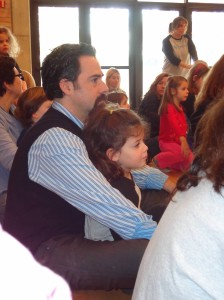 Generally, when I take Lena to school, I leave Gray and Hope in the car in the front driveway of the building because Gray gets so excited/overstimulated in a preschool setting. He generally comes bursting in the classroom and begins his tornado-style assault on the toys, books and other children. Puzzle pieces fly, pages are chewed and torn and hair is pulled. It can be a mess untangling him from the chaos and he generally gets very upset when we have to leave quickly. But, today, we could stay and enjoy Shabbat and I felt confident that he would enjoy it.
Generally, when I take Lena to school, I leave Gray and Hope in the car in the front driveway of the building because Gray gets so excited/overstimulated in a preschool setting. He generally comes bursting in the classroom and begins his tornado-style assault on the toys, books and other children. Puzzle pieces fly, pages are chewed and torn and hair is pulled. It can be a mess untangling him from the chaos and he generally gets very upset when we have to leave quickly. But, today, we could stay and enjoy Shabbat and I felt confident that he would enjoy it.
When we arrived in Lena’s classroom, he immediately let go of Hope’s handle and started pulling towards the enticing items around the room. Fortunately, the tether did not let him go very far. I told him that he needed to grab his handle so we could move on to Shabbat, and he complied with only a little protest. As we walked down the hallway, he strolled nicely by my side and reached for Lena’s hand so that he could walk with her. After entering the noisy music-filled sanctuary, he took a little time to select the perfect seat before settling in nicely. It was such a pleasant time with him moving from his chair to my lap to Lena’s chair as he clamored to get the best view of the action at the front. It wasn’t at all manic, it was just happy and engaged. About 15 minutes in, he climbed on my lap facing me and threw his arms around my neck. He had the brightest smile on his face as he pressed his lips onto mine so hard that I had to brace myself.
When it was time to take the children back to the classrooms, we walked with Lena’s class through two lines of teachers who were singing and clapping and shaking tambourines. Instead of getting revved up like I expected, he just grinned up at them and kept pace with the other kids. As I looked around and witnessed the scene, all I could think was, “He looks just like the other kids right now and he is loving it!” That’s when I got emotional. He is not at all like the other kids, but I will revel in the brief moments when we can feel that way.




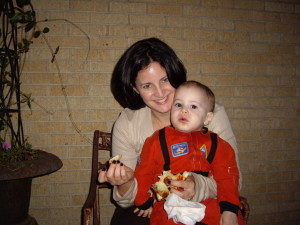
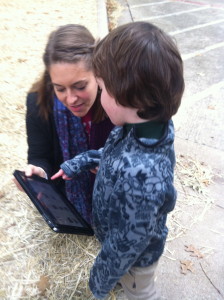
Recent Comments